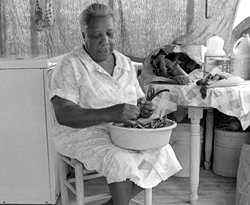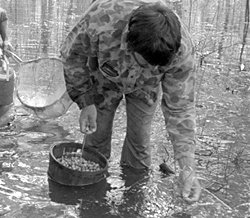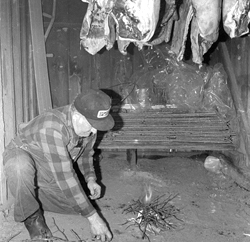
Farm And Domestic Crafts
If you've seen anything done once, you can do it if you're interested. -- Howard Henry
I don't throw away nothing; whenever a thing's too ragged for one thing, make another one out of it. -- Annie Rene Harris
In the 19th century, all members of the agricultural spectrum -- planters, yeoman farmers, sharecroppers, and poor black and white farmers -- relied to a large extent on handmade tools and other items used in farm operation and in the home. Usually farmers made these themselves, or obtained the services of another more skilled member of the community. In the case of slaveholders, slaves were often taught the necessary crafts needed for the farm and home. Many of these crafts have been passed on to surviving generations of blacks and whites in north central Louisiana. A number of the traditional crafts found take advantage of the natural environment and by-products from cultivation or other domestic activities so that little is wasted.
The forest provided white oak for baskets, which were made in large sizes for cotton or small for gathering and storage. Today white-oak baskets are still made; however they are more likely sold to community members who use them for nostalgic decorative purposes. White oak also still provides wood for handles as do pine and other woods.
Carved walking sticks are another favorite wood item and may be made from hickory, gum, willow, or other small saplings. While whittling itself is a traditional pastime, some of the forms made are visionary rather than traditional, especially among black carvers such as David Allen, who carves walking canes using a number of motifs which may occur to him in dreams or in imaginative visualization.

Along more traditional and functional lines, some farm equipment such as plows and singletrees are still homemade by farmers such as Dennis Clark and Victor Tabor. Boards (or shingles or shakes) are still rived from cypress and pine to be used for roofing small sheds; however, the prevalent roofing material is sheet iron. A few woodcarvers such as Truett Moore can make bowls (for kitchen use) from maple or tupelo gum. In general, those who continue a woodcarving tradition can make a variety of traditional functional objects and toys and also may attempt to copy modern or commercial forms as well.
Some farmers continue to grow gourds to fashion into birdhouses, dippers, scoups, and storage containers. Said to ward off snakes, gourds are also grown just for decorative and traditional purposes. Corn crops also furnished cornshucks for making mule collars, whip crackers, chair bottoms, or hats; today only a few people such as Nonie Waters, Leola Simmons, and Dennis Clark have knowledge of these crafts. Although farms in the past also provided raw materials such as leather from cowhide and cotton from fields for crafts such as whip-making and chair-bottoming or quilting, today these materials must be purchased. Blacksmithing crafts are slowly disappearing with only a few blacksmith shops remaining on farms such as Homer Eaves'. Mr. Eaves still uses his forge to sharpen plows and in the past constructed tools such as hoes, logging grabs, and other farming equipment. Interestingly, most of his iron for blacksmithing came from old automobile parts, which he structured into new forms.
In many respects domestic crafts have fared better than farm crafts. Probably the most popular, quilt-making, is done in both rural and urban areas. In earliest days of the area settlement, thread was spun and fabric woven and dyed for clothing. Scraps of cloth left over from this and from purchased cloth were saved to piece patchwork quilt tops, which would later be quilted by women in the family or community. Today, most traditional quilters continue to save remnants from sewing or factories; consequently, many of the newer quilts are made from polyester knit rather than the traditional cotton. Church groups, senior citizens, homemakers' groups, and friends still get together for quilting; however, for the most part, quilting has become a solitary pastime like the piecing of the quilt was previously.
Other forms of needlework such as crocheting, hairpin lace, tatting, and embroidery are still done today. Although some women learned these crafts only with the aid of printed instructions, most frequently, they learned by observation and individual tutoring. Today needle crafts have been so much influenced by the popular commercial patterns and instruction books that it is often difficult to separate the popular from the traditional forms.
In the midst of the popular crafts craze of today, it is not surprising that traditional crafts remain as strong as they are. Many older craftspeople attribute their continuing practice to their inability to just sit and do nothing; they have a great need to "keep the hands busy." Many craftspeople do make distinctions between the traditional crafts and the more transient popular ones; as quilt-maker Moselle Durrett sees it:
I just like to create things, to make something worthwhile. A lot of people take these detergent bottles and cut out and make something; well, really I don't feel like I've done anything when I do such as that. What I want to do is something that is worthwhile to show for what I've done, I guess. There's a woman lives here that takes clocks and she takes these egg cartons and she cuts them up and puts them around [the clock]. When she gets through,it's big, and she uses clothes pins and all -- well, I really don't feel like you have much when you done that because it's not something that will last on; of course, it's showy, maybe, but it's just not my type...It does show right now but it's not lasting [like quilts].
Foodways
My first memory of making biscuits, I was so short I couldn't reach the cabinet. My mother fixed me something to stand on. She fixed the well and put the staff in there and let me mix it up and take them [the biscuits] out. Gradually I got to where I could do the whole thing. -- Maxine Otwell
Subsistence food crops for early settlers included corn, sweet potatoes and black-eyed peas, green vegetables, sugar cane for syrup, free -ranging hogs and some cattle (Shugg 1939: 44; Kniffen 1968: 139).
Although the foods are no longer relied on for subsistence, they are still a large part of the north central Louisiana diet in rural areas. The diet has often been accused of having too much fried food. As early as 1869, geographers Samuel Lockett's account voiced this complaint about the piney wood food in Louisiana:
Three times a day for nearly 365 days a year, their simple meal is coarse corn bread and fried bacon. At dinner there will be added perhaps collards or some other coarse vegetable. Even when they have fresh meat of venison, which they can obtain whenever they wish, it is always fried and comes to the table swimming in a sea of clear, melted lard. (Lockett 1969: 48).
Chances are that Lockett was visiting in a season other than summer, for in that season, vegetables are often the staple of the rural North Louisiana diet, even today as reported in a 1981 editorial in the Shreveport Times:
It's just that our favorite happens to be steaming,fresh-picked white butterbeans. But we will vary that with purple-hull peas as a main entrée. Like Grandma,we can do without a formal meat dish when vegetablesare available...but long slender slices of hard rindbacon -- salt meat -- are required.
If peas and butterbeans are on the table, hot-butteredeggbread is preferred. But hotwater bread or hush-puppies will suffice...New potatoes cooked in a smooth white sauce ought to be flanked with a large platter piled high with handspread-sized shining tomato slices. Wash all that down with either iced tea sweetened in the pitcher or thick smooth buttermilk... (Hilburn 1981: 5).
For special occasions such as Sunday dinner, fried chicken, chicken-fried steak, or pork chops might be added to the above menu, and other types of beans (string, pinto, pole), or peas (speckled, black-eyed, cream, lady, or English) served with homemade tomato sauce, chow-chow and/or cucumber or peach pickles, and corn (cream style or corn on the cob) could be included. Often raised in home garden plots, these foods and other vegetables in various combinations are common today in rural white and black families and in urban ones if vegetables are available. These may be served throughout the year now with the aid of home freezers and traditional canning. Freezing, and to a lesser extent, canning, preserving, and drying out of vegetables and fruits are domestic chores still widely practiced by women such as Sarah Albritton and Maxine Otwell, in the summer in rural and small towns in North Louisiana.
Although fewer hogs today are butchered and cured on the farm as in earlier years, farmers still choose to butcher their own hogs, smoke their own pork, and make their own sausage and scrapple, a variant of hogshead cheese (Figure 12). Even in homes which do not butcher their own hogs, such traditional meats as cracklins and chitlins, available at local processors and grocers, are prepared.

Wild game including such "delicacies" as fried or stewed squirrel, fried quails, venison (usually fried), barbecued "coon", roast "possum" with sweet potatoes, and fried fish and boiled crawfish are still served occasionally, primarily in hunting and fishing families near the forests, lakes, and rivers. Often the game obtained is used as a special celebration meal -- a fish fry or a barbecue.
The wilds also furnish a variety of berries and fruits which are a valued part of the north central Louisiana diet. These include black berries, dew berries, elder berries, choke berries, muscadines, scuppernongs, and mayhaws (Figure 10). Gathering or picking these fruits is often considered an important seasonal family endeavor also, with both husbands and wives taking part.
The foodways of the hill country are perhaps the best preserved traditions in spite of the influx of packaged convenience and fast foods and other ethnic dishes which are also popular. The introduction of these new items has added more variety to menus, but traditional dishes and their preparation have hardly been affected.



